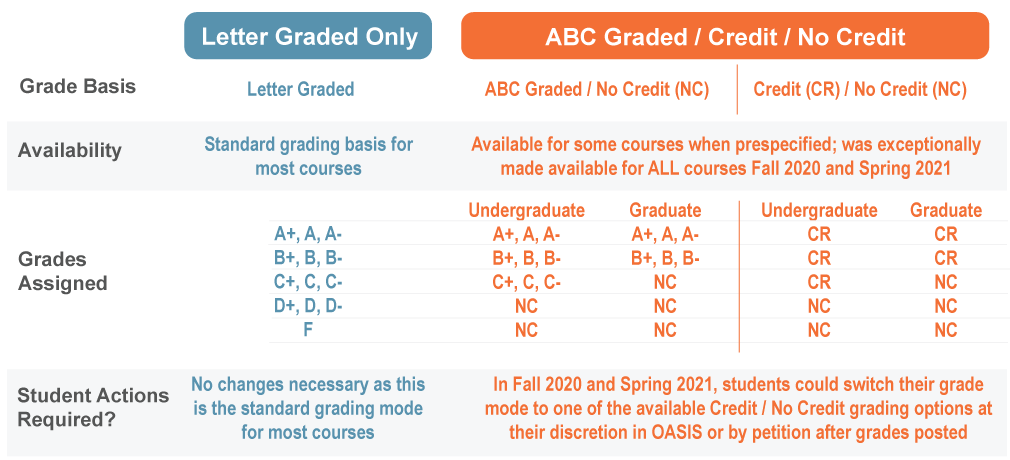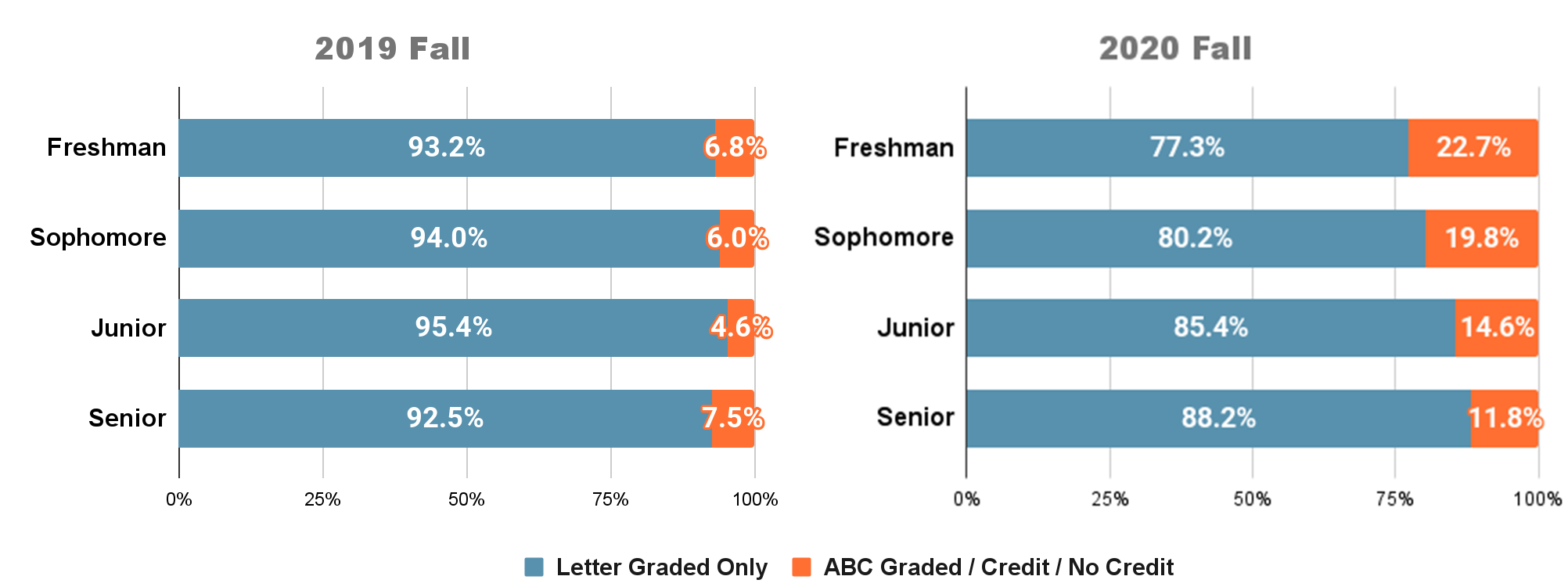IAR Insights - Fall 2021

In this issue:
Course Outcomes During COVID-19: A Comparison Between Fall 2019 and Fall 2020
- What Impact Did COVID-19 Have on Grading Policy at CSUMB?
- What Impact Did the Changed Grading Policy Have on Grade Modes Selected?
- How Did the Percentage of DFW Grades Change from 2019 Fall to 2020 Fall?
- What Impact Did the Changed Grading Policy Have on Term and Cumulative GPAs?
- Where Can You Find More Information About Course Outcomes Across Terms and See Data Related to Your Program?
What Impact Did COVID-19 Have on Grading Policy at CSUMB?
In 2020 Spring, the impact of the coronavirus pandemic (COVID-19) led to a rapid move to remote virtual learning as well as temporary changes in CSUMB’s academic and grading policies.
In the 2020 Fall term, with a majority of courses being offered online, CSUMB elected to allow students to select their grade mode for their classes through the Otter Academic Student Information System (OASIS) up until the end of term or by petition after grades were posted.
Students could choose from the following grade basis options for each of their courses:

Note: No Credit (NC) grades do not earn units, do not meet requirements, and do not meet prerequisite grades; NC grades do not count in the calculation of students’ cumulative or term grade point averages (GPAs).
In 2020 Fall, students could make changes to their grade bases for each class beginning December 8, 2020, and continuing through December 18, 2020, the last day students could make the change themselves in OASIS without having to petition.
What Impact Did the Changed Grading Policy Have on Grade Modes Selected?
Comparison of Grade Bases Selections 2019 Fall to 2020 Fall
Degree-Seeking Undergraduates by Academic Level at Start of Term
- Freshman students took advantage of the grade mode policy changes in 2020 Fall, that included the ABC Graded / Credit / No Credit options, at a greater rate than students at other undergraduate class levels, followed by Sophomores, Juniors, and then Seniors.

Data Source: CSUMB Data Warehouse > Courses Dashboard > Course Enrollment Demographics. Explore.
Note: Analysis includes only courses with Enrollment Section Class Type and students in Undergraduate Baccalaureate and Ex Ed UG Baccalaureate Academic Programs with Grade Basis of Letter Graded, ABC Graded / No Credit, and Credit / No Credit. “ABC Graded / Credit / No Credit” includes “ABC Graded / No Credit” and “Credit / No Credit” Grade Bases.
Degree-Seeking Undergraduates by General Education (GE) and Non-GE Courses
- Undergraduate students in GE courses, in particular, took advantage of the ABC Graded / Credit / No Credit options in the 2020 Fall term as compared to the prior year when all were Letter Graded; in non-GE courses, the percentage of students opting for the ABC Graded / Credit / No Credit options also increased, but to a lesser extent.

Data Source: CSUMB Data Warehouse > Courses Dashboard > Course Enrollment Demographics. Explore.
Note: Analysis includes only courses with Enrollment Section Class Type and students in Undergraduate Baccalaureate and Ex Ed UG Baccalaureate Academic Programs with Grade Basis of Letter Graded, ABC Graded / No Credit, and Credit / No Credit. “ABC Graded / Credit / No Credit” includes “ABC Graded / No Credit” and “Credit / No Credit” Grade Bases.
Degree-Seeking Graduate Students
- Graduate students also took advantage of the ABC Graded / Credit / No Credit options in the 2020 Fall term as compared to the prior year, but the difference between years was less than for undergraduate freshmen, sophomores, and juniors.

Data Source: CSUMB Data Warehouse > Courses Dashboard > Course Enrollment Demographics. Explore.
Note: Analysis includes only courses with Enrollment Section Class Type and students in Ex Ed Graduate and Postbac Masters Academic Programs with Grade Basis of Letter Graded, ABC Grade / No Credit, and Credit / No Credit. “ABC Graded / Credit / No Credit” includes “ABC Graded / No Credit” and “Credit / No Credit” Grade Bases.
How Did the Percentage of DFW Grades Change from 2019 Fall to 2020 Fall?
- For both degree-seeking undergraduate and graduate programs, higher percentages of DFW grades (includes D+, D, D-,F, I, IC, NC, W, or WU) were awarded in 2020 Fall than in 2019 Fall.
- For undergraduate groups, the increased percentage of DFW grades ranged between 2.2% and 3.0% and for graduate students it was 0.6%.
Degree-Seeking Undergraduates

Data Source: CSUMB Data Warehouse > Grades Dashboard > DFW Grades. Explore.
Note: Analysis includes only students in Undergraduate Baccalaureate and Ex Ed UG Baccalaureate Academic Programs.
Degree-Seeking Undergraduates by First Generation

Data Source: CSUMB Data Warehouse > Grades Dashboard > DFW Grades. Explore.
Note: Analysis includes only students in Undergraduate Baccalaureate and Ex Ed UG Baccalaureate Academic Programs.
Degree-Seeking Undergraduates by Underrepresented Minority

Data Source: CSUMB Data Warehouse > Grades Dashboard > DFW Grades. Explore.
Note: Analysis includes only students in Undergraduate Baccalaureate and Ex Ed UG Baccalaureate Academic Programs.
Degree-Seeking Undergraduates by Received Pell Aid

Data Source: CSUMB Data Warehouse > Grades Dashboard > DFW Grades. Explore.
Note: Analysis includes only students in Undergraduate Baccalaureate and Ex Ed UG Baccalaureate Academic Programs.
Degree-Seeking Graduate Students

Data Source: CSUMB Data Warehouse > Grades Dashboard > DFW Grades. Explore.
Note: Analysis includes only students in Ex Ed Graduate and Postbac Masters Academic Programs.
What Impact Did the Changed Grading Policy Have on Term and Cumulative GPAs?
- Term GPAs and Cumulative GPAs were higher for both degree-seeking undergraduates and graduate students in 2020 Fall as compared to 2019 Fall.
- For degree-seeking undergraduates, the increases in Term GPAs and Cumulative GPAs were larger for first generation students compared to not first generation students, for underrepresented minority (URM) students compared to non-URM students, and for students that received Pell aid compared to students that did not receive Pell aid.
Degree-Seeking Undergraduates

Data Source: CSUMB Data Warehouse > Grades Dashboard > Term and Cumulative GPAs. Explore.
Note: Analysis includes only students in Undergraduate Baccalaureate and Ex Ed UG Baccalaureate Academic Programs that had Units Taken for GPA and an Academic Load greater than zero.
Degree-Seeking Undergraduates by First Generation

Data Source: CSUMB Data Warehouse > Grades Dashboard > Term and Cumulative GPAs. Explore.
Note: Analysis includes only students in Undergraduate Baccalaureate and Ex Ed UG Baccalaureate Academic Programs that had Units Taken for GPA and an Academic Load greater than zero.
Degree-Seeking Undergraduates by Underrepresented Minority

Data Source: CSUMB Data Warehouse > Grades Dashboard > Term and Cumulative GPAs. Explore.
Note: Analysis includes only students in Undergraduate Baccalaureate and Ex Ed UG Baccalaureate Academic Programs that had Units Taken for GPA and an Academic Load greater than zero.
Degree-Seeking Undergraduates by Received Pell Aid

Data Source: CSUMB Data Warehouse > Grades Dashboard > Term and Cumulative GPAs. Explore.
Note: Analysis includes only students in Undergraduate Baccalaureate and Ex Ed UG Baccalaureate Academic Programs that had Units Taken for GPA and an Academic Load greater than zero.
Degree-Seeking Graduate Students

Data Source: CSUMB Data Warehouse > Grades Dashboard > Term and Cumulative GPAs. Explore.
Note: Analysis includes only students in Ex Ed Graduate and Postbac Masters Academic Programs that had Units Taken for GPA and an Academic Load greater than zero.
Where Can You Find More Information About Course Outcomes Across Terms and See Data Related to Your Program?
You can access the source data for each of the analyses featured in this edition of IAR Insights and explore these data by College and Major via the Guided Navigation in the CSUMB Data Warehouse.
Note: The CSUMB Data Warehouse requires access and being connected to the campus network via VPN if you are accessing from off-campus.
Definitions for data elements used in the analyses for this IAR Insights can be found in the CSUMB Data Glossary.
Connect With IAR
IAR is located in Green Hall (Building 58).
Have questions about any of the analyses mentioned in this volume of IAR Insights or any of IAR’s other reports or dashboards?
Register for one of our upcoming Data Exploration Open Labs, which are held twice per month via Zoom.
You can also contact iar@csumb.edu for help with any of our reports or data.